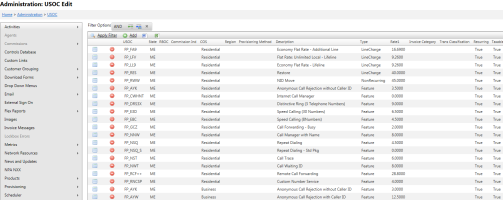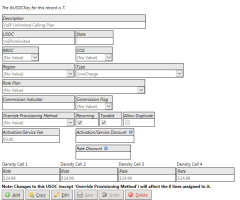Master USOC - Administration (Traditional Local/VoIP Charges)
| How do I get here? | Setup ► Products ► Local/DID ► USOCs |
| Purpose |
Master USOCs (Universal Service Order Codes) are used to define the master list of Local / VoIP Product Charges in TBS. These charges can then be associated with one or more Local / VoIP lines in the system. TBS supports the following types of USOC charges:
USOCs are added to products on the Local/VoIP USOC selection screen |
| Security | ProductsAdmin module |
| Taxing Impact | USOC Type |
| Commission Impact | Commission Flag Commission Indicator |
| Data Field Definitions | View Here |
USOC Inventory - The Master USOC List shows all Local/VoIP charges currently defined in TBS. Users can sort and filter the grid to easily find the desired Master USOC record.
USOCs are tied to Local/VoIP products in TBS. The inventory provides an easy way to store a list of charges and packages that apply to the services being offered. USOCs may be stored in Inventory with a specific dollar amount or with a 0.00 dollar amount.
$0.00 amounts are often used when pricing is not consistent across customers or if the USOC item is tied in with another package USOC charge, but the USOC is still added to the product individually for customer service and provisioning purposes.
![]() There are a few important notes about how the system handles changes to existing Master USOCs:
There are a few important notes about how the system handles changes to existing Master USOCs:
- When editing a USOC, above the command buttons is a bold note that shows how many lines this USOC is attached too. Any changes to the USOC (except the Override Provisioning Method) will impact all of these lines. For example, if a rate is changed from $1.00 to $2.00, then all lines with that USOC will be charged $2.00 during the next bill run.
Selecting Add new record or clicking the ![]() pencil icon will open the Master USOC detail record as shown below. If adding a USOC similar to an existing USOC, it is sometimes easiest to select the existing USOC and then select the Copy button. Provide a new name for the USOC and save any changes to the new USOC.
pencil icon will open the Master USOC detail record as shown below. If adding a USOC similar to an existing USOC, it is sometimes easiest to select the existing USOC and then select the Copy button. Provide a new name for the USOC and save any changes to the new USOC.
Please be sure to review the USOC Data Field Definitions and the Taxing in TBS documentation regarding taxing of USOC charges.

